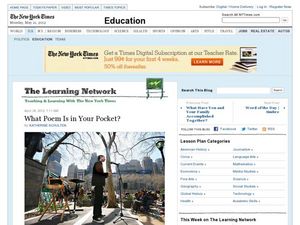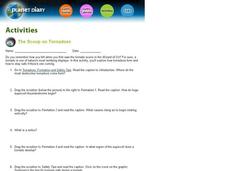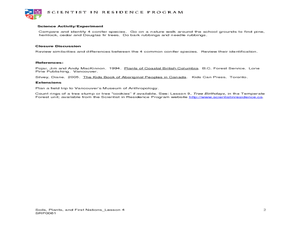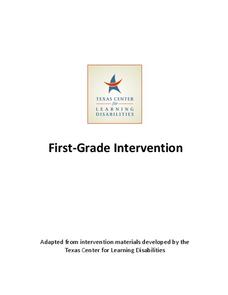Newseum
Civil Rights: Chronicling the Movement
Scholars investigate events in the civil rights era in their community and develop a multimedia presentation of their findings. They compare local events with national events discussed on a NewseumED timeline.
Curated OER
Poem in Your Pocket Day: Ideas for Celebrating
First instituted in New York City in 2002 and recognized nationwide in 2009, "Poem in Your Pocket Day" is part of National Poetry Month (April) and celebrates poetry in everyday life. A brief news story includes 9 ideas about how to...
Curated OER
The Scoop on Tornadoes
Use an online interactive worksheet to guide your young scientists into the fascinating world of tornadoes! Links to weather articles from the National Weather Service and Planet Diary give clear explanations as well as visual depictions...
Curated OER
First Nations Contributions
Eleventh graders recognize the contributions made my Indigenous people around the world. In this research skills lesson, 11th graders research native peoples of several countries and create presentations that feature the contributions of...
Curated OER
Diversity: Origin Myths
Fifth graders analyze origin myths and the diversity of First Nations groups. In this history lesson, 5th graders review the geography of Canada and read various origin myths. Students illustrate one of the myths and research...
Curated OER
Western Red Cedar
Learners explore the First Nations uses of the Western Cedar tree. In this nature lesson students compare and identify four conifer species. The learners go on a nature walk.
Curated OER
Contributions
Students explore the history of Canada by analyzing the First Nations' citizens. In this Native Canadian contributions lesson, students research the geography of Canada and create a book about the First Nations' involvement in the...
Curated OER
Alaska
In this Alaska worksheet, students complete 6 pages of readings and questions about the state of Alaska. Included are general facts, First Nation groups, European arrival, industry and people. Each page has a short text and 6 multiple...
Curated OER
Legends as Oral History
Sixth graders read First Nations legends to find information about the First Nations. In this legends as oral history lesson, 6th graders interview and write oral histories from family members.
Student Handouts
A New Presidency
Use this quick informational text to give your class an introduction to President Bill Clinton and Hillary Rodham Clinton, first lady at the time of the events in the text. Individuals or partners can read the brief text and respond to...
Texas Center for Learning Disabilities
First-Grade Intervention
Learning how to read is a big challenge for young learners, but this series of lessons provides them with the extra support they need to succeed. With each lesson following the a clearly outlined format, children are introduced...
Education World
Every Day Edit - First Hot-Air Balloon
Daily practice develops skills! Use this half-sheet to help learners correct grammatical errors in capitalization, punctuation, spelling, and grammar. Today's topic is a hot-air balloon flight.
Curated OER
2003 U.S. National Chemistry Olympiad Part III
In this chemistry Olympiad worksheet, pupils are given 2 lab problems to work on. They must explain their experiment they would carry out, show their data and write their results and conclusions of the lab and the process.
National Museum of Australia
Telling Our Indigenous Stories
How far back is 40,000 years? Scholars research the first indigenous people in Aboriginal Australia. Using museum artifacts, maps, and background readings, they form conclusions on the life of the first Australians and their struggles to...
Curated OER
What They Left Behind: Early Multi-National Influences in the United States
Students research the impact of European voyages of discovery and colonial influence on different aspects of American culture. They access a number of online sources and reference maps to trace the influences of England, France, Holland,...
Curated OER
Science: Teddy Bear Nation
Students sort teddy bears according to types and then graph the results. They each bring a bear to class and then discuss their similarities and differences. Once the bears have been sorted into groups according to size and color,...
Curated OER
The Causes and Course of the First World War
Use this twelve-day lesson plan to teach about the causes and courses of WWI. Each day scholars attend lectures, complete creative activities, and hold round table discussions on what they've learned. Web links and resources are...
Facing History and Ourselves
Identity Charts
Many factors shape the identity of persons, communities, and even nations. Tweens and teens have an opportunity to consider the many aspects of identity as they create a graphic that reflects who they are. Class members first brainstorm...
National Gallery of Canada
My First Print
Practice printmaking with a fun lesson. After observing images, class members use the listed materials, such as stamps and sponges, create their own prints. They experiment with layering, pressure, and paint colors.
PBS
Abraham Lincoln: Man versus Legend
Abraham Lincoln was one of the greatest presidents ever ... right? Scholars research the accomplishments and struggles of the Lincoln presidency. They uncover facts, materials and information via video clips, primary, and secondary...
Utah Education Network (UEN)
8th Grade Poetry: Narrative Poem
The first lesson of a five-lesson unit designed for eighth graders has class members reading and watching a video of Edgar Allen Poe's narrative poem, "The Raven." They then craft their narrative poem, illustrate it, and share their work...
Utah Education Network (UEN)
8th Grade Poetry: A to Z Poem
A two-part lesson asks eighth graders first to draw connections between the myth of Aengus and William Butler Yeats' poem "The Song of Wandering Aengus." In the second part of the lesson, writers craft an "A to Z Poem."
Utah Education Network (UEN)
7th Grade Poetry: Metaphor Poem
The second instructional activity in a five-part poetry unit asks seventh graders to construct a metaphor poem. First, pupils examine Emily Dickinson's "The Railway Train" and identify the metaphor. They then select an object and an...
iCivics
Step 1: Change the World?
Want to change the world? Where do you begin? Scholars analyze the steps that must take place to make change in society. The first installment of a 10-part County Solutions - High School series brings the real world to the forefront as...
Other popular searches
- First Nations Athletes
- First Nations Art
- First Nations Veterans
- First Nations People
- First Nations of Alberta
- First Nations Canada
- Canadian First Nations
- First Nations I Alberta
- First Nations Peoples
- First Nations Architecture
- Canada History First Nations
- First Nations Communities























